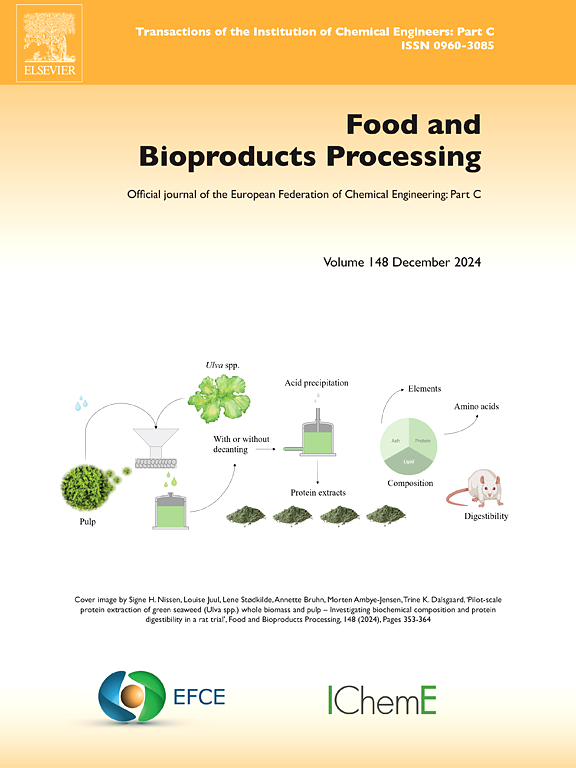Antibacterial cellulose-based membrane with heat dissipation and liquid transportation for food packaging applications
IF 3.5
2区 农林科学
Q2 BIOTECHNOLOGY & APPLIED MICROBIOLOGY
引用次数: 0
Abstract
Food spoilage, caused by fungi and bacteria, has drawn increasing attention due to the lack of suitable temperature and humidity control, resulting in food waste and health risks. It is still a great challenge to develop green packaging materials with excellent antibacterial activities and effective temperature/humidity control for food preservation. Herein, a new strategy is proposed to obtain food packaging material with antibacterial ability, heat dissipation, and liquid transportation functions. In this strategy, Zn-Al layered double hydroxide (LDH)@cellulose was obtained by extracting cellulose from sugarcane husks, followed by in-situ growth of LDH nanosheets on the surface of cellulose. Then, asymmetric structured packaging material, namely cellulose acetate/LDH@cellulose (CALC) membrane, was prepared by the combination of electrospinning and hydrophobic modification. The characterization results confirmed that the CALC membrane exhibits asymmetric surface structure and wettability properties, endowing heat dissipation and liquid transportation for food packaging applications. Due to the asymmetric reflectivity and infrared emissivity, the CALC membrane exhibited excellent heat dissipation properties with a surface temperature of 10.3℃, which is lower than that of commercial food packaging materials. Furthermore, the excellent liquid transport properties of the CALC membrane are demonstrated by the fact that water can penetrate from the hydrophobic side to the hydrophilic side within 32 s, providing the appropriate storage temperature and dry environment for foods. In addition, compared with PE film, the CALC membrane also has antibacterial properties and UV resistance, which is beneficial to improving the storage conditions for foods. This study shows that the developed CALC membrane and corresponding design strategy can be extended for the preparation of other packaging materials for applications in research and food industrial fields.
用于食品包装的具有散热和液体输送功能的抗菌纤维素基膜
由于缺乏适当的温度和湿度控制,导致食物浪费和健康风险,由真菌和细菌引起的食物腐败日益引起人们的关注。开发具有良好抗菌活性和有效控温控湿的绿色食品包装材料仍然是一个巨大的挑战。为此,提出了一种获得具有抗菌、散热和液体输送功能的食品包装材料的新策略。在该策略中,通过从甘蔗皮中提取纤维素得到Zn-Al层状双氢氧化物(LDH)@纤维素,然后在纤维素表面原位生长LDH纳米片。然后,采用静电纺丝和疏水改性相结合的方法制备了非对称结构包装材料——醋酸纤维素/LDH@cellulose (CALC)膜。表征结果证实了CALC膜具有不对称表面结构和润湿性,有利于食品包装的散热和液体输送。由于具有非对称的反射率和红外发射率,CALC膜具有优异的散热性能,其表面温度为10.3℃,低于商用食品包装材料。此外,CALC膜具有优异的液体传输性能,水可以在32 s内从疏水侧渗透到亲水侧,为食品提供合适的储存温度和干燥环境。此外,与PE膜相比,CALC膜还具有抗菌性能和抗紫外线性能,有利于改善食品的储存条件。本研究表明,所开发的CALC膜和相应的设计策略可以扩展到其他包装材料的制备,应用于研究和食品工业领域。
本文章由计算机程序翻译,如有差异,请以英文原文为准。
求助全文
约1分钟内获得全文
求助全文
来源期刊

Food and Bioproducts Processing
工程技术-工程:化工
CiteScore
9.70
自引率
4.30%
发文量
115
审稿时长
24 days
期刊介绍:
Official Journal of the European Federation of Chemical Engineering:
Part C
FBP aims to be the principal international journal for publication of high quality, original papers in the branches of engineering and science dedicated to the safe processing of biological products. It is the only journal to exploit the synergy between biotechnology, bioprocessing and food engineering.
Papers showing how research results can be used in engineering design, and accounts of experimental or theoretical research work bringing new perspectives to established principles, highlighting unsolved problems or indicating directions for future research, are particularly welcome. Contributions that deal with new developments in equipment or processes and that can be given quantitative expression are encouraged. The journal is especially interested in papers that extend the boundaries of food and bioproducts processing.
The journal has a strong emphasis on the interface between engineering and food or bioproducts. Papers that are not likely to be published are those:
• Primarily concerned with food formulation
• That use experimental design techniques to obtain response surfaces but gain little insight from them
• That are empirical and ignore established mechanistic models, e.g., empirical drying curves
• That are primarily concerned about sensory evaluation and colour
• Concern the extraction, encapsulation and/or antioxidant activity of a specific biological material without providing insight that could be applied to a similar but different material,
• Containing only chemical analyses of biological materials.
 求助内容:
求助内容: 应助结果提醒方式:
应助结果提醒方式:


